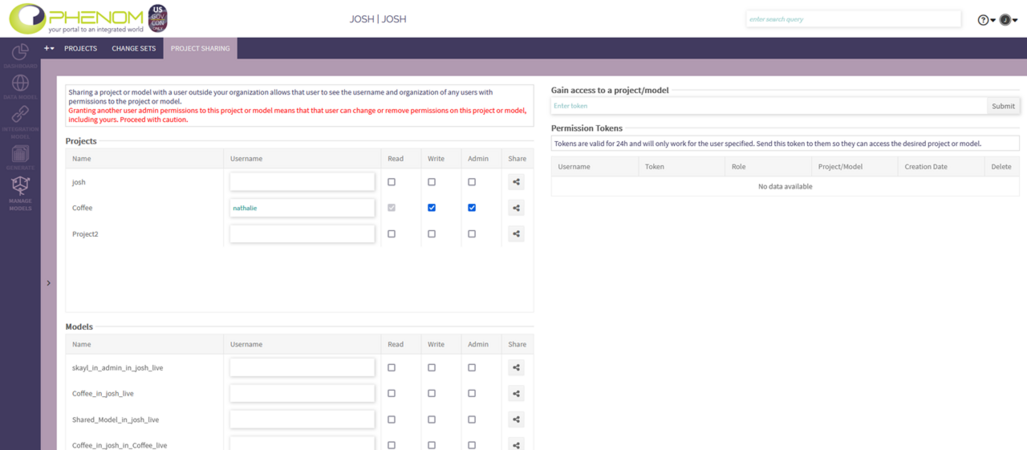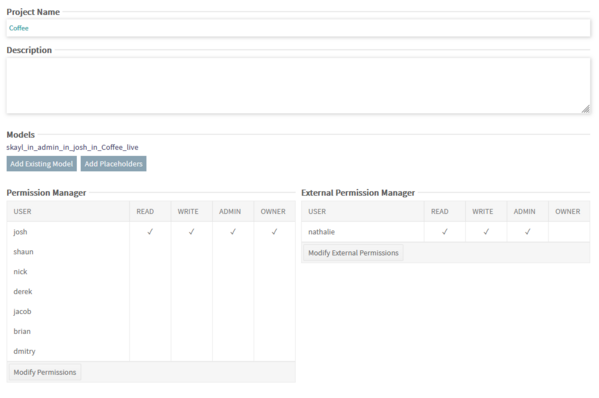Permissions: Difference between revisions
No edit summary |
No edit summary |
||
| Line 30: | Line 30: | ||
= Assign Permissions = | = Assign Permissions = | ||
== Assign Permissions to | == Assign Permissions to Internal Users == | ||
Users are able to assign permissions to their models by using the Permission Manager on the Model Details | Users are able to assign permissions to their projects or models by using the Permission Manager on the Project or Model Details page. The table lists all the users from the same account as the current user. | ||
[[File:Perms1.png|alt=Project Details Page Permissions Manager|frameless|1023x1023px]] | [[File:Perms1.png|alt=Project Details Page Permissions Manager|frameless|1023x1023px]] | ||
To be able to share a model, | To be able to share a Model, users need to have Admin or Owner permissions to it. The types of permissions users can grant depend on the the permissions they have to the model. | ||
To be able to share a Project, users need to have Admin or Owner permissions to it and to all the models it contains. The types of permissions users can grant depend on the the permissions they have to the project and its models. The type permissions granted for the project will be applied to all its models. | |||
{| class="wikitable" | {| class="wikitable" | ||
| Line 50: | Line 49: | ||
| Read + Write + Admin + Owner|| Read, Write, Admin, Owner | | Read + Write + Admin + Owner|| Read, Write, Admin, Owner | ||
|} | |} | ||
== Assign Permissions to External Users == | == Assign Permissions to External Users == | ||
| Line 62: | Line 54: | ||
* Go to the Project Sharing page | * Go to the Project Sharing page | ||
* Locate the project or model to be shared | * Locate the project or model to be shared | ||
* Enter the username and the desired permissions level | * Enter the username and the desired permissions level<sup>*</sup> | ||
* Click the Share button | * Click the Share button | ||
* Email the generated Token (which appeared on the right of the screen) to the user. | * Email the generated Token (which appeared on the right of the screen) to the user. | ||
Note that the Token is only valid for 24 hours. | Note that the Token is only valid for 24 hours. | ||
<sup>*</sup> The types of permissions users can grant follow the same policy as for internal users (see table above) except that they can't grant Owner permissions even if they have Owner permissions themselves. | |||
[[File:Perms2.png|alt=Project Sharing Page|frameless|1027x1027px]] | [[File:Perms2.png|alt=Project Sharing Page|frameless|1027x1027px]] | ||
Revision as of 16:44, 29 April 2024
Permissions are a user's access level to either a project or a model. There are four different types of permissions, and a user can have any of the permissions types independent of one another. Permissions on a project and the models it contains are distinct (i.e., the user can have different permissions (higher or lower) at the project level compared to the models).
Permissions Types
Read Permissions
If a user has Read permissions, they have read-only access to the project or model.
Having Read permissions to a project and its models allows the user to switch to that project, see all the content, export the content, but not create, edit, or update it. In addition, if the model inherits from another model, a user with Read permissions is allowed to see the nodes that can be pulled from a parent model, but are prevented from actually pulling that content. Likewise, if a model has other models that inherit from it, a user with Read permissions to the model is allowed to see the push requests from the children models, but is not allowed to approve those changes.
Read permissions are unique from the other permissions types in that they are required in order to have any other permissions. For that reason, when assigning Write, Admin, or Owner permissions, Read permissions are assigned by default and can't be removed, as seen below.
UPDATE IMAGE WITH OWNER COLUMN FILLED
Write Permissions
If a user has Write permissions, they are allowed to edit project and model content.
Having Write permissions to a project or a model allows the user to modify any of its content, including pulling, pushing, and approving push requests. Note that to pull changes from a parent model, the user needs at least Read permissions to the parent model.
Admin Permissions
If a user has Admin permissions, they are allowed to make changes to projects and models themselves.
Having Admin permissions to a project or a model allows the user to change the metadata of the project or model and create inheriting projects or models. They can also set the permissions of other users (belonging to their own account) to this project or model up to Admin.
Owner Permissions
If a user has Owner permissions, they have the same permissions as Admins, as well as some additional actions.
Having Owner permissions to a project or a model provide the user with Admin permissions plus the ability to delete the project or model, and to share it with users external to their account. Owner users can grant permissions up to Owner for internal users and Admin for external users.
Assign Permissions
Assign Permissions to Internal Users
Users are able to assign permissions to their projects or models by using the Permission Manager on the Project or Model Details page. The table lists all the users from the same account as the current user.
To be able to share a Model, users need to have Admin or Owner permissions to it. The types of permissions users can grant depend on the the permissions they have to the model. To be able to share a Project, users need to have Admin or Owner permissions to it and to all the models it contains. The types of permissions users can grant depend on the the permissions they have to the project and its models. The type permissions granted for the project will be applied to all its models.
| Current User Permissions | Target User Permissions Options |
|---|---|
| Read + Admin | Read, Admin |
| Read + Admin + Owner | Read, Admin, Owner |
| Read + Write + Admin | Read, Write, Admin |
| Read + Write + Admin + Owner | Read, Write, Admin, Owner |
Assign Permissions to External Users
To assign permissions to users that do not belong to the current user's account, the user has to give them a Permissions Token. The procedure to do so is as follows:
- Go to the Project Sharing page
- Locate the project or model to be shared
- Enter the username and the desired permissions level*
- Click the Share button
- Email the generated Token (which appeared on the right of the screen) to the user.
Note that the Token is only valid for 24 hours.
* The types of permissions users can grant follow the same policy as for internal users (see table above) except that they can't grant Owner permissions even if they have Owner permissions themselves.
To gain access to the project or model, the user has to go to the Project Sharing page, copy the Token received by email in the dedicated field and click the Submit button. The new project or model should then appear in the their project/model tree.
This user, along with any other external users, will appear in the Permissions Manager under a separate External Users table.
Account Admins
Account admins are able to see all the projects and models that exist on their account, and are able to assign permissions to those projects and models to any user on the same account up to Owner permissions. In case a project or model was shared to someone on an account using a Permissions Token, that account's Admins are only allowed to assign permissions to the project or model that someone on the account holds. WHAT?




